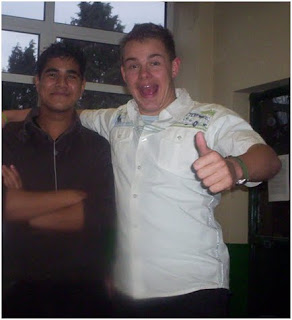Thursday, December 10, 2009
How did you use new media technologies in the construction and research, planning and evaluation stages?
You Tube
I used You Tube to research many different existing videos which allowed me to search and view existing music videos, also it enables me to look at different videos with information on pop up videos, dancing in the distraction factory and also mirror ball.
DVD's
Watching documentries on different directers such as Spike Jonze and Micheal Gondry, where they explain thier ideas and how they directed the music videos, one of the songs is Everlong, by the Foo Fighters, We learnt how the video was choreographed and directed.
Microsoft Excell
We used this to produce our graphs, it was fairly easy to use, all that was required was the question numbers, and the feedback votes.
Wikipedia
I used wikipiedia to research information on pop up videos, existing songs, our song information, music genre information. There was one setback with using it, although there was plenty of information, it was user edited, which meant that the information was placed up the viewers and users, meaning there is also fake information.
Internet Search Engines
We used internet search engines to find the majority of out information. We used mainly google and occasionally yahoo.
In my Planning I used the following technologies:
Online Blog - I used this blog which you are viewing to upload most of the posts of ideas and designs. This has been fairly easy to use, although managing photos has been a small issue, which I was able to overcome simply by changing the settings.
Internet Search Engine - I used Google to search for our songs lyric's which we found suprisingly quickly.
In the construction of our product I used the following technologies:
High Definition Camcorder
For filming the footage we used the Sony HDR-SR10E, a high definition camcorder, this had a number of advantages which aided us to get our footage quickly and easily in the correct quality. As it is a harddrive based camcorder, we did not need to use disks or special wires to place our footage on a computer to edit.
iMac
We used an Apple Mac computer to contruct our footage into our final product, with its high tech speciafications, we found using it easy, very fast and reliable, loading our footage and converting it into the correct format took half has long as we thought. As the Mac is known for having some of the best software known, we had all the recources for making a good music video.
Final Cut Studio
This is a well known movie making software made specially for the iMac, some of the features and effects were like we had never seen. After carrying out some research on this product, we found out that it was used by several different media firms for putting together thier TV series, such as the american action series: Leverage.
PhotoShop and Fireworks
I used Adobe Photoshop and Fireworks to crop, edit, and create our album covers they both had different features, which is the reason I used both of them and not just one editing software. For example, I used Photoshop for cropping the photos and seperating the layers, which i then copied into fireworks to colour and put the croppings in together to form one image.
I used the following technologies to evaluate my product:
You Tube
I used You Tube to upload the finished music video, by doing this peers and other users could easily view the product without having to watch it from a disc or the computer it was produced on. Also this meant that people could comment on our product and give us opinions on how we could improve it.
We used the social interaction website where both my partner and myself were registered upon, we placed a link and tagged ourselves in the music video so our friends on facebook could view it through facebook. I also used Facebook to contact Lily Allen.
What have you learnt from your audience feedback?
Class Criticism
Our music video was played a few times to the rest of our class so we could gain effective feedback and contructive critisism from colleagues and teachers. We also played the movie to an AS media class of year 12s to see their thoughts and impressions of our music video.
Youtube
After uploading our video on to Youtube, we recieved some responses from other internet users who viewed our music video and commented thier thoughts and opinions on it. This allowed to reflect upon the strengths and weaknesses of our video
General Public Reviews
Nikil and I invited 100 members of the general (at random) to watch and review our music video. This gave us the advantage of using a wider range of feedback.
Once we had completed our first draft of the video, Nikil and I decided to work out which video clips needed to removing or editing in order to create the new footage for the film.
Originally, we had a shot of Matt falling over and clenching his leg in pain. We both agreed to the removal of this footage as the feedback and comments which reffered to the shot being too diverse to the rest of the footage. Although it added that extra comical hint to our music video, we removed it and replaced it with the shot of Courtney, gazing out of the window.
Near the beginning of our drafted music video, there was a small clip of me, walking around in my front garden. Many of the reviews stated that it did not fit into the music video smoothly, even though it had relation to the first line of the lyrics.
"You say that you wonder your own land."
we replaced this with more footage of close ups and angles to focus more on the musicains.As there were hardly any special effects in our video we decided to add the photo tearing transition effect, this took a long time but was worth it as it gained more positive comments.
When we finished editing the footage, we again placed the new version on you tube, and showed our classmates and teachers, this time round we gained many more postitive comments. Below are some examples:
"I like the way you made this average Lily Allen song look great with the video "
"The footage fits well with the lyrics "
"The lip synching is amazing, it goes precicely in time, so does the guitar"
Contacting Lily Allen
In order to receive permission to create this music video, I had to contact Lily Allen to let her know that I was going to create a music video for her song. below is the message UI sent her on Facebook:
Hi Liz,
Me and my media group decided to make a music video using your song "Everbodys Changing" and we were wondering if this was ok with you.
Thanks, Peter.
....Unfortunately, we never received a response. At least we let her know what we were doing.
How effective is te combination of your main product (Music Video) and the ancillery text (Magazine Advert & Album Cover)?

To make the album cover we decided not to use anything from the music video for album cover because we noticed that even though many of Lily Allen's album covers do this, we wanted to be like the majority of other professional artists and to have something colour and aesthetically pleasing. Therefore, we decided to make them both, completely from scratch. We acquired the image of the evolution chain and the image of the different people in different stances and position from Google Images. Nikil and I then used Adobe Photoshop to crop and colour the upper image of the people as its original form was different. We also had to do the same with the evolution chain image as its background colour was also different. After editing both images we placed them in Adobe Fireworks and put them together with the font, after colouring the rest of the background green, the cover was done.
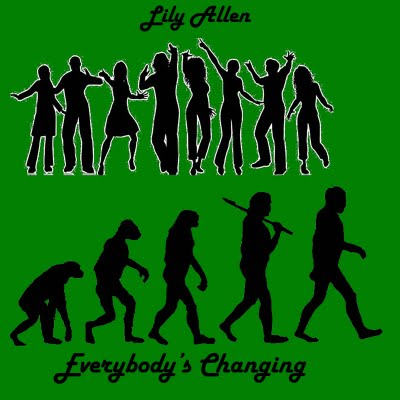
Parts of this design was related to the song itself, it has an image of the evolution of man - from the ape to human, this related to the song name - Everybody's changing as there was a clear image of the ape changing into the form of a man. Also the upper image of the different people standing in different stances and positions related to the song name, it relates to the song name as all of them are different and changing stances as the image goes along.
This album cover had almost no similarities to the original albums, as we made two album covers, the second design was related to the existing albums as it had a comical and humourous aspect to it, this is similar to the existing covers as most of them have a comical style and occasionally an image or two made for humour.
In my opinion the final cover did not have many eye catching features and it did not have any special colours or patterns on it, the only colours used on it was black, white and green, although there was only these three colours, a certain part of it made it very bold and attractive.
To get more feedback on our covers we asked fellow students what they thought on our covers, most of them voted the first design to be the better one, and that it suited the song name and theme more than the other design did.
A logo is recognisable picture, usually backed up by a slogan, which is the reason companies logo all of their products in some way or another. Most of the worlds most recognisable logos have little or no words in them, they just contain one or two items or words. This has also been replicated by artists who are or want to be recognised by just a small logo.
In what ways does your media product use develope or challenge the forms and conventions of music video?
Lip Syncing
If you can't lip synchronise a song for a media video, you might as well consider failing. It is paramount that it is done correctly and accurately to make the song and video synchronise effectively together. If the audio and video are out of synchronisation, a huge majority of entertainment is lost and the work becomes a great disappointment. Professional musical artists ensure that their miming or singing is in sync with their music before it is released. Our music video uses a large amount of lip syncing, which we managed to make awesomely without error. We were able to do this through using the special secret of miming a song: You must actually play the song on set whilst being filmed as it then makes the process impossible to muck-up. To eliminate the song being played, you simply mute all video recordings when it comes to the editing phase.
Visual Effects
The use of visual effects enhances a music video, making it come to life. What attracts the eye the best are optical illusions as they can easily boggle the mind effectively through a simple process. There are of course more common visual effects such as Computer Generated Illustrations and caricaturisation which tend to make the video well worth the watch.
In the extras of our DVD, you can find the title, "It Ain't Over Yet". This was just our group having a bit of fun with CGI and what can e produced. You are able to see the effects of gunshot wounds with blood splatters, explosions and a rifle being fired with the addition of muzzle flashes, ejection of empty cartridges and sound effects. All of which are fake and have been bopped on. We created this short video realising that it couldn't be used within our music video, rendering it all most useless. However, we did add it into the DVD extras to prove that we can use such techniques. Please watch this small video as it is quite amusing!
Our song is an average paced song and unfortunately has little or no sounds which could have been used with visual effects. We challenge this by using fading effects and a special transition effect - where the photo is torn in half - as it tears the next shot is shown through the photo ripping in half.
Close-ups
Close ups are essential for the creation of music video. They are most commonly used when viewing the musician singing or playing an instrument, just like at the point of a guitar solo. This gives a great effect as it is able to stun the audience through sheer beauty and skill. This can be formed by creating a series of close up shots to show emotion, relation, importance and lip syncing. An example of close-eps in our music video is when Courtney, our female character in the relationship, is gazing out of the window. We use the close-up on this camera shot as it projects her sadness.
Fast Edits
Fast clips played for a period of short time tend to add tension and excitement within the Music Video's atmosphere. These fast paced clips are most common in music such as drum and bass, rock, metal... We develop and challenge this convention by using both slow and fast edits in our music video e.g the changing volume of coffee in the coffee filter and the mug is sped up. This was done to prove the point f time passing by at a fast pace.
Montage Edits
This is when one type of footage cuts to another type, for example footage of a rapper walking in a street miming the words, cutting to footage of cars, buildings or other people. Our music video challenges this as we have footage of the artists performing with cuts to flashbacks of our two characters.
Names and Titles
Every music video played on any music channel has the name of the song, the artist(s) and possibly the name of the album the song is featured in. Our music video uses this as it has the song name and artist name at the beginning and we challenge it by not including it at the end. We did this because the lyrics do not tend to differ, most of them are consistently sung.
The Artist as the Character/Actor
In most music videos the artist is the singer or actor. This is happens on most occasions because there is more focus on the artist and this is used to catch people's attention. In other music videos the artist is the narrator of the storyline but does not sing. Some music videos have the artist seen rarely in the video not at all, an example of this is the release of, "Rockstar", by Nickelback. In this music video he only appears at the very end. Rather than a famous actor or artist singing, Nickelback has chosen a vast range of singers, ranging from different ages, genders and races. Our music video uses and develops this as it features the artist as the singer, but not as the actor.
Narrative
The majority of music videos have some kind of storyline which refers lyrics being sung. This is called Illustration. However, music videos do vary quite a lot, for instance, some music videos have some links and relations to the lyrics but still have some parts which make little sense. This is called Amplification. The last type of music video is Disjuncture, which normally has very little or no relation to the song's lyrics or style.
Our music video uses and develops this as most of the video has a direct link to the lyrics of the song, there are two parts in which there is little relation, this makes our music video an Amplification. This is proven through points such as the camera shot of my dog, "Toby". The shot represents how everybody's changing and in this situation, the tough do has grown some fluffy rabbit ears. However, this footage is fairly random in-comparison to the rest of the video.
Tuesday, December 8, 2009
My Magazine Advert & Album Cover Designs
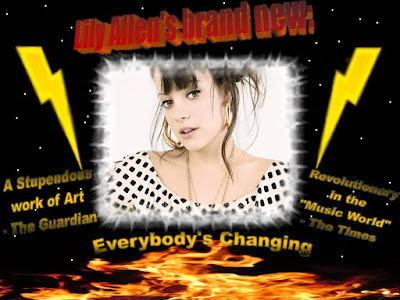 Above is the magazine advert that I created. You can see on the advert that I have used statements from The Guardian and The Times. These statements are false but they are there to simulate the complimentary comments from famous brands and tabloids.
Above is the magazine advert that I created. You can see on the advert that I have used statements from The Guardian and The Times. These statements are false but they are there to simulate the complimentary comments from famous brands and tabloids. Above is the album cover that I created. I used the idea of evolution in this album cover which is demonstrating the change of ape to man, as it shows how everybody is changing. The same point goes to the picture of the people at the top who are different and have there own stance.
Above is the album cover that I created. I used the idea of evolution in this album cover which is demonstrating the change of ape to man, as it shows how everybody is changing. The same point goes to the picture of the people at the top who are different and have there own stance.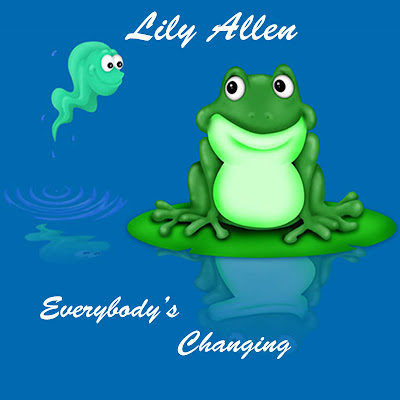 Above is one of the possible album covers Nikil and I created together. We liked the idea of a tadpole swimming (more like jumping!) alongside a frog. The cartoon effect shows a slightly comical hint to it, which would initially refer back to the music video we made.
Above is one of the possible album covers Nikil and I created together. We liked the idea of a tadpole swimming (more like jumping!) alongside a frog. The cartoon effect shows a slightly comical hint to it, which would initially refer back to the music video we made.In order to create the magazine advert and the 2 album covers, I used Photoshop and Paint to create them both.
Tuesday, December 1, 2009
Plan of Action
We assessed what equipment was required inorder to create the music video and sought suitable locations to undertake the filming. We also knew that we wouldn't be able to complete the video purely by ourselves. Luckily, I had enlisted the help of some close friends who are keen amateur actors and have access to various essential equipment that would be vital for constructing and editing our video.
Filming the Story
The base line to the song is about the narrator of the story , who is the singer, describing about their own relationship and how they're beginning to struggle coping and they don't know what to do next. I understand that the meaning of the lyrics make this quite a sad song, however, the lyrics are entirely different to the actual music which is extremely happy and enthusiastic. This made Nikil and I come to the conclusion that we should make the music video for this song peaceful and comical.
The major musicians of the song are the singer and a guitarist. We decided that we were going to have a singer and a guitarist in the majority of our music video as they would represent the narrators of the storyline. It would also represent an important convention of music video - continuity.
Now that we had our actors, Nikil and I were to select a location to start shooting our media film. We found our ideal location fairly quickly and we were both pleased. We had decided to film in Werrington, just outside our actor's house on the green. The landscape is mainly grass with a few shrubs and trees dotted about, here and there. This landscape covers up the majority of the surrounding houses within the camera shots.
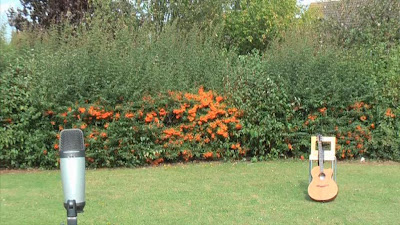 For our opening scene, we decided to have the singer, Jessica, and the guitarist, Pete, walk into the shot where they would find their microphone and guitar. It is an extreme close-up shot of Jessica's face on the left hand side of the screen. On the right hand side of the screen, we are able to see a mid-shot of Pete picking up his Guitar in Black and White as he appears. Nikil and I decided that shots like this were to occur throughout the music video. This is because you can see how the singer is the main focus of the song, yet, she is backed up by the guitarist in the background. You can see the comical element of the music video when you suddenly see Pete rotating and standing on the chair he was originally seated on.
For our opening scene, we decided to have the singer, Jessica, and the guitarist, Pete, walk into the shot where they would find their microphone and guitar. It is an extreme close-up shot of Jessica's face on the left hand side of the screen. On the right hand side of the screen, we are able to see a mid-shot of Pete picking up his Guitar in Black and White as he appears. Nikil and I decided that shots like this were to occur throughout the music video. This is because you can see how the singer is the main focus of the song, yet, she is backed up by the guitarist in the background. You can see the comical element of the music video when you suddenly see Pete rotating and standing on the chair he was originally seated on. 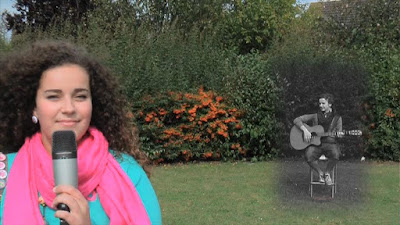
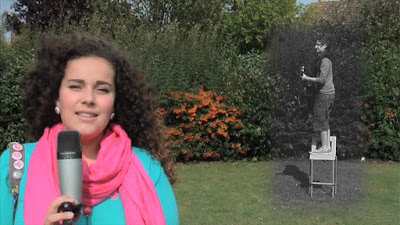
The second scene begins to show the storyline of a couple who split up. They are played by Matt and Courtney. In the 1st shot, of this scene, we can see the emotions of Courtney as she gazes through the front window of what is her boyfriend's house, looking for her boyfriend. This shot reflects upon the lyrics of the song :
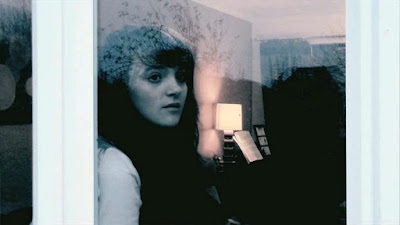
"...I can see the pain in your eyes."
This camera shot clearly demonstrates these emotions, especially with the grey-scale effect that was added - which I feel added a level of grittiness and sincerity to the shot. This shows that whatever is happening, it is currently in an unhappy time of the relationship.

This is followed by an over shoulder shot of Courtney, closely followed by the camera zooming out. This is when we see Matt, Courtney's partner, return home and enter the room. He clearly isn't happy with her and this is shown through his physical-body language. The original baseline is that Courtney has been cheating on Matt and upon discovering this, Matt is extremely distraught and returns home. We then see Courtney stand up from where she was seated. This conveys the secret message that she is rising from an inferior position and she is trying to reach Matt's level. You can easily notice how the camera is rather unstable. This is due to the fact that I did not use a tripod to aid the camera's stability. I did this on purpose as it mimics the turbulance of the relationship.
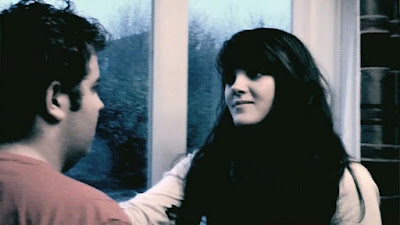
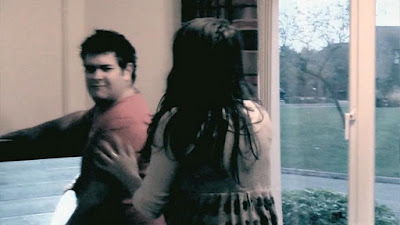
Courtney reaches out to him but is quickly rejected by Matt. Courtney realises that there is no sympathy for her and she makes a speedy exit.
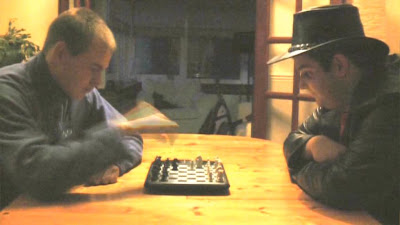
The third scene shows a camera shot of me playing a chess game against Matt. This has been sped up to ensure that the audience can understand what is actually happening. This clip was added into the video because it is referred to in the lyrics:
"...I'm trying to make a move just to stay in the game,"
The fourth scene is similar to the 1st camera scene but slightly different in the fact that Pete is now at the front playing his guitar and Jess is in the background singing. We chose this environment for the camera shot as you can see how the screen has carefully been divided by Pete, Jess and a tree.
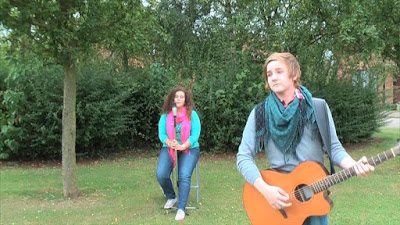
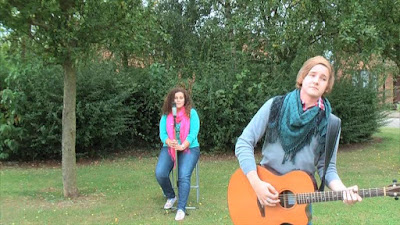
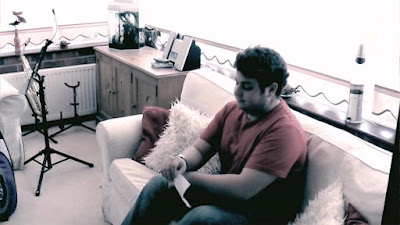
The fifth scene is of Matt, sitting down and holding a photo of himself with Courtney when they loved each other. The camera is positioned from a high angle pointing downwards. This shows Matt's current emotions and his low self-esteem. He is melancholic and reflecting upon what has happened to their relationship.
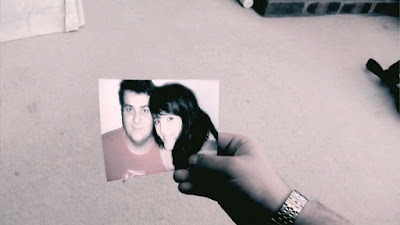

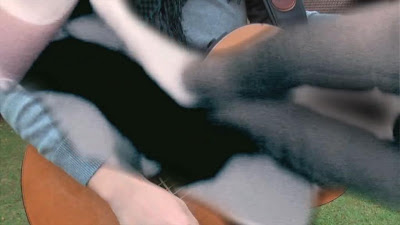
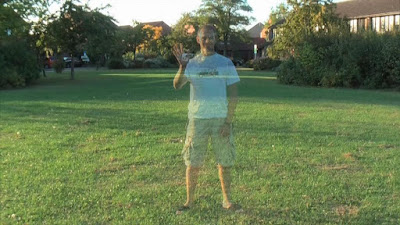
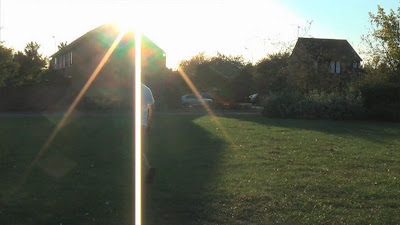
Below is the camera shot which is a flashback that explains the history of the relationship between Matt and Courtney when it was in it's good stage.
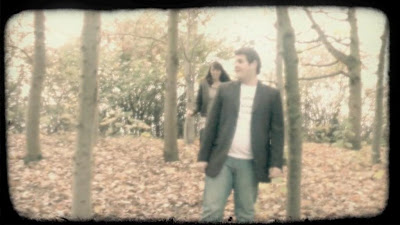
We decided to fade this shot from Matt and courtney to Pete and Jess to show how there is a connection between the narrators (Singer and Guitarist) and the actual couple.
 One of the shots we chos to use was were you can see Jess singing, but Pete is playing his Guitar whilst sitting in a bush. This was added to enhance the comical side of our music video.
One of the shots we chos to use was were you can see Jess singing, but Pete is playing his Guitar whilst sitting in a bush. This was added to enhance the comical side of our music video.

Monday, November 23, 2009
Lily Allen: Everybody's Changing - Lyrics
But when I think about it
I don't see how you can
You're aching, you're breaking
And I can see the pain in your eyes
Says everybody's changing
And I don't know why
So little time
Try to understand that I'm
Trying to make a move just to stay in the game
I try to stay awake and remember my name
But everybody's changing
And I don't feel the same
You're gone from here
Soon you will disappear
Fading into beautiful light
`Cause everybody's changing
And I don't feel right
So little time
Try to understand that I'm
Trying to make a move just to stay in the game
I try to stay awake and remember my name
But everybody's changing
And I don't feel the same
So little time
Try to understand that I'm
Trying to make a move just to stay in the game
I try to stay awake and remember my nameBut everybody?s changing
And I don't feel the same
Everybody's changing
And I don't feel the same.

Sunday, November 15, 2009
Music Videos relating to songs : Research No. 4
Disjuncture
Disjuncture is a term used to describe music videos which mean very little and have hardly any form of relation to the song. They work by ignoring the original song by creating a brand new group of meanings and conventions. This is a redical tecnique used by arty bands to show their difference and originality. Normally disjuncture videos do not make much sense and may be based on artistic, random and abstract imagery. For example "Da Punk" by Dark Funk, directed by Spike Jonze.
Illustration
A Music Video can paint a general picture of what the lyrics mean and the genre of the song, and can even provide an actual group of relevantly selected images. Illustration is one the most renowned and most classic sample of visualisation, everything in the music video is based on the source of the pop song.
Amplification
The most persistant type of video increases value to the song. Amplification is seen as the mark of the true music video Auter - the director as the artist. This type is different to Disjuncture as it is related to the song and still has links to the meanings of the lyrics in the song with the video still enhancing and developing the ideas.
Tuesday, October 27, 2009
conventions of music video : Research No. 3
To aid us in our research regarding Music Videos, we have decided to create a questionnaire and our sample group is 100 people of both genders and their ages range from between 13 - 60 years. The purpose is to try and define what type of music is most popular for creating music videos, how long is the preferred average music video and what sort of content is most ideal for the public. Below is the questionnaire which I will hand out to 100 participants:
1.) What genre of music videos do you like to watch?
a.) County & Western b.) Drum & Bass c.) Pop d.) R & B e.) Rock

2.) What do you like to see portrayed in a music video?
a.) Love relationship b.) Band orientated story c.) News + Politics d.) Imagery of the Future

3.) Which of the following would you want see more?
a.) Cartoon Animations b.) The Band playing c.) Computer Generated Graphics
The results of my questionnaire shows a number of different results. You can see that there is a trend where the majority of people who took the questionnaire prefer to watch music videos based on Pop music (52% of the results) that has a love relationship involved in the footage (66% of the results) as well as the additional of some footage of the band actually playing (87% of the results). These results will help me narrow down what type of song I should create for a music video and what to include within it. Doing this would allow my music video to attract the vaster majority of the general public as I have found out what is preferred amongst the public.
Monday, October 19, 2009
Synaesthesia Research No. 2
Within this approach you would need to begin with the actual music/symphony and to establish an understanding of how the song works by taking into account the way it has been stacked and piled on with sound. To begin, lyrics do not need to be analysed and compared word for word throughout, but considered for the what they show the mood and general feeling to be. The lyrics are vital as they create the subject matter and storyline. Key Phrases, the Chorus and Key Lines will have a meaning and a part to play in the visuals associated within the song.
Roland Barthes created his theory about the "Grain of Voice". It means that the singing voice is more of an expressive instrument, personal and unique to the singer, therefore being able to create and develop associations in itself. Barthes believes that this should result in a lot more close-up camera shots on the singer, as they should be identified as the most important person in the band.

Monday, October 5, 2009
Outline on Music Videos
Pop-Up Video
Pop-Up Video is a VH1 television show that "popped up" Bubble — officially called "information nuggets" — containing wry witticisms and trivia throughout music videos. The show was created by Woody Thompson and Tad Low and premiered October 27, 1996. For a time, it was the highest-Nielsen Ratings program on VH1, until "Behind the Music" had overtaken it by 1998. Although VH1.com still listed Pop-Up Video in its programming roster, it has not been aired regularly on the network since it was ended on August 8, 2002, and the show's page is now an error page, meaning that it cannot be displayed any more.

It used to run on Canada's MuchMusic and MuchMoreMusic. The show, until recently, aired nightly on VH1 Europe, but is currently run only on special occasions, such as Pop-Up Video weekends. As of December 2006, Pop-Up Video airs on VH1 Classic.
Dancing in the Distraction Factory

This is a book of which I was recommended to read by my media teacher. He said that it is a comprehensive, integrated analysis of MTV which provides new ways to understand television and popular music narratives. Reading it would help boost my knowledge of music videos in order to assist me make the guideline to creating my own.
The author of the book, Andrew Goodwin, has an approach that is multidisciplinary, highly detailed, very perceptive-and it works in relation to his ideology about music videos. The industrial approach to music television covers a lot of ground and provides the kind of clear, focused thinking so often lacking in other accounts of MTV. It is a thoroughly researched and annotated book that is accomplished in focusing upon the heart of music television and its relationship with popular culture of today's society.
This book firmly takes on the postmodern analysis of MTV as it deliberately portrays the unmeaningful images which are called in the trade 'blank parodies' of other texts. Goodwin, the author, achieves his ambition to 'advance and reframe' the debates around music video and music television. It's smart context has an impact on the debates surrounding popular culture. Andrew Goodwin’s co-editor, Garry Whannel, is a corresponding editor of the international communications journal Media, Culture, and Society. This has helped Goodwin out as he can prove that he also has an expert's opinion upon his shared ideas.
Mirror Ball
Mirrorball was originally created at the Edinburgh International Film Festival in 1996. Its aim was to prove to the world that the best music videos were worth more than a passing critical
glance and that their directors were talents worth watching. It proclaimed that pop promos, rather than short films, were where the next generation of Hollywood stars would learn and advance their film-making skills.
Mirrorball was a seven part series on shown on Channel 4 in 1999/2000. The program looked at the work of pop promo directors; Spike Jonze, Michel Gondry, Jonathan Glazer, Chris Cunningham and Dawn Shadforth, Jonas Auckland & Roman Coppola With the exception of Dawn Shadforth, Jonas Akerlund & Roman Coppola- all the featured material featured in the Mirrorball programs can be found on the Palm DVD releases "The work of director..."
In the years since it was launched, Mirrorball has co-produced two television series (in conjunction with Blackwatch Productions) for Channel 4. Mirrorball has toured the UK extensively presenting film events at the National Film Theatre, Curzon and at regional film theatres across the country. Mirrorball has also participated in international festivals in Australia, Japan and throughout Europe presenting curated programmes of work by promo directors from all corners of the globe including Sonar Festival, Barcelona and SxSW, Austin.
Sunday, August 30, 2009
Inspirational Music Videos : Research No. 1
Red Hot Chilli Peppers - Under The Bridge
Under The Bridge was released sometime in March 1992. It begins with the guitarist (John Frusciante), playing his guitar on a small platform inside a studio. Behind him is a view of a desert and an inverted sky. This lasts for the whole first introductory solo. The guitarist is only ever seen in this position. The singer (Anthony Kiedis) then appears, coated in purple light with a starry background behind him. After a while, a city skyline appears below him.
In several clips of the video, the bassist (Flea) and the drummer (Chad Smith) can be seen, playing away at their instruments. A lot of superimposition is used for these moments (several clips being placed over one another so that all of them are visible). One technique used for this is to position the clips in different sections of the screen, e.g. the drummer will be playing on the right whilst the singer is standing on the left. This ties in with the idea of "Mise-en-scene", a key camera shot where you can see many things happening all at once. The singer then walks through the streets of a city, while the camera focuses on different people throughout.
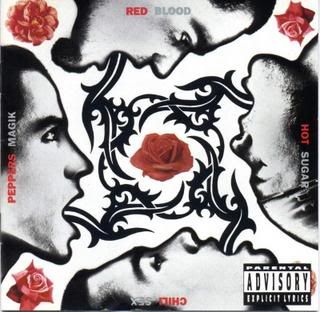
The director of the video, Gus Vant Sant, said that this was vital as they believed the studio portion would not convey enough emotion. He also said that it is needed to be combined with "an outdoor, streets-of-Los-Angeles theme." Near the end, the singer is seen running along a river, and an atomic bomb is going off in the background. Around the same time, the other members are shown through superimposition.
Near the end of the video is a clip where a car is driving down a road at night. This clip is in slow motion but the frame rate is significantly cut down. This makes the many street lights look more dazed. The video ends like it started, with the guitarist playing on the pedestal. Now, the background is an inverted ocean instead of a sky.
Green Day - When I Come Around
When I Come Around uses a lot of cameras which are 'tracking'. It uses the conventional format of having a storyline running parallel to the band, but the band is not performing. They are just walking through streets. The singer, is still lip syncing. This supports the idea that the singer is most important as he is in front and he is the only member doing what he would do while performing.

Whenever the band is shown, the camera is in front of them and the band is following the camera. The story is quite original - a person is standing in a house, and he looks over the street through the window to see someone else. That person is then looking at another person smoking in the streets, while he is looking at a couple kissing. The cycle continues until the last person looks back at the first person the viewer saw, making a continuous cycle.
Incubus - Drive
Drive is a more modern song than When I Come Around and uses an interesting effect throughout the video. The lead singer is shown 'drawing himself' on some paper. The video shows the band performing, but only the guitarist and singer are shown playing their instruments all the way through. Most of the time, it shows the band relaxing, however, sometimes the turn-tablist, bassist and drummer are seen playing.
There are almost no still camera shots because the camera rarely stands still, usually zooming in or panning round one of the band layers, for example, during the guitar solo, the camera is upside down, giving the video a very peculiar image to it. The guitarist is shown the most here, but all the other members are seen as well, also playing upside down. The drummer has been filmed playing but has been slowed down by editing the clip into slow motion, which can be easily noticed due to the drumstick which he is spinning with his hands. This not only looks awesome but the clip has to be in slow motion because if the drumstick was spinning rapidly, it would not fit into the slowish tempo of the song. As the solo ends, it switches from the Guitarist playing upside down in a smooth transition to the singer standing the correct way up.

The music video draws to an end when the audience is able to visualise the iconic animation of the singer ripping up the piece of paper he had originally been drawing on at the start of the music video, showing a full circle to the baseline to the video's convention. The location of the video was shot at the fairly modern McNamara Alumni Centre.
After carefully and thoroughly examining these renowned media videos, I hope to utilise and adapt some of the techniques used in these videos for the benefit of our video as they are professional and look highly effective.
Wednesday, August 26, 2009
Song Ideas

Our first chosen songs:
- ACDC - Black in Back

- Creedence Clearwater Revival - Fortunate Son
- Jimi Hendrix - Purple Haze
- Stranglers - Hanging Around
At the very start of the project, Nikil and I thought about what we could do to create an ideal music video. We had originally discussed  about the idea of incorporating some footage from 3 video games we both knew and played quite a lot; Battlefield 1942, Battlefield 2 and Battlefield Vietnam. A close contender for the music video was the track "Purple Haze"written during the Vietnam War (1965 - 1975) by the legendary Jimi Hendrix. This game play (footage from a video game) would have ideally fitted into the video as it illustrated genuine historical combat footage and hence clearly demonstrates the war. It portrayed this in two ways firstly at a certain time of the year in Vietnam there is a natural purple haze that forms in the top canopy of the rainforest. Secondly, it has been well documented that due to the horrors of this war many very young soldiers turned to drugs in order to cope and block out the scenes of warfare, and therefore this led to them functioning under the influence of drugs and their thought processes being hazy.
about the idea of incorporating some footage from 3 video games we both knew and played quite a lot; Battlefield 1942, Battlefield 2 and Battlefield Vietnam. A close contender for the music video was the track "Purple Haze"written during the Vietnam War (1965 - 1975) by the legendary Jimi Hendrix. This game play (footage from a video game) would have ideally fitted into the video as it illustrated genuine historical combat footage and hence clearly demonstrates the war. It portrayed this in two ways firstly at a certain time of the year in Vietnam there is a natural purple haze that forms in the top canopy of the rainforest. Secondly, it has been well documented that due to the horrors of this war many very young soldiers turned to drugs in order to cope and block out the scenes of warfare, and therefore this led to them functioning under the influence of drugs and their thought processes being hazy.
The starting point of planning of our project was to combine the selected song we would have carefully chosen with various types of different military/battlefield footage, for example, air strikes by high-speed jets mixed with the gritty ground combat and the addition of naval combat too. We had planned to create and obtain the majority of this footage from using a screen capture software called FRAPS that we were both very familiar with and knew exactly how to use. We would then use this computer program to record the audio and visuals from our gameplay whilst playing military action games such as Battlefield 1942, Battlefield 2 and Battlefield Vietnam. These three video games are very realistic in comparison to a real battlefield and depict an idea picture of what we wanted. We know it is realistic because they were reviewed by game testers and people who genuinely fought in these particular battles. These reviews both stated how realistic all 3 games are.
Our idea was to compare the combat from the times of World War 2, the Vietnam War and Modern Warfare. The songs that we were going to choose were also made and released around the time of the Vietnam war, so it would suit the style of the video we wanted.
To obtain some actual military/battlefield based footage, Nikil and I had planned to go to an air show at Duxford, Cambridgeshire. Attending an airshow would enable us to observe and film different war planes from the various ages. They would be on display and would fly insane stunts and flybys over the area and in front of us. We would film the planes as they flew over perilously low doing stunts and simulated dogfights. This real-life footage would be absolutely ideal to enhance our music video and to help portray the devastation and reality of war.
One of the camera shots we wanted to use was to a "Mise-en-scene" camera shot. Ideally I would have had someone dressed up in a military uniform, preferably the singer, positioned and stationary at the end of a runway whilst a plane is taking off directly above them. We would have then edited this clip by slowing it down and mixing it with a sort of purple-haze effect.
Below is a screen shot from the ideal video we were going to use:
I had recognised the song as it was originally sung by Keane. After listening through the entire song I knew that this song would be the ideal piece of music to create a video. The rationale was that upon hearing the lyrics I knew that I could easily create a story-board. I personally don't like this version of the song sung by Lily Allen. My preferance is the original release by the group Keane, but their track was too lengthy and therefore, wasn't suitable to make an effective video, whereas Lily Allen's version of the song is just the ideal amount of time.

Tuesday, July 21, 2009
Our Media Group
Below is a link to the final piece of work I submitted for last year's course: www.youtube.com/watch?v=EaBLn5VAFb4
Below is a link to the original version of our AS media work:
www.youtube.com/watch?v=WcgDca78bvw&feature=related
Below is a picture of Nikil (Left) and I (Right).
